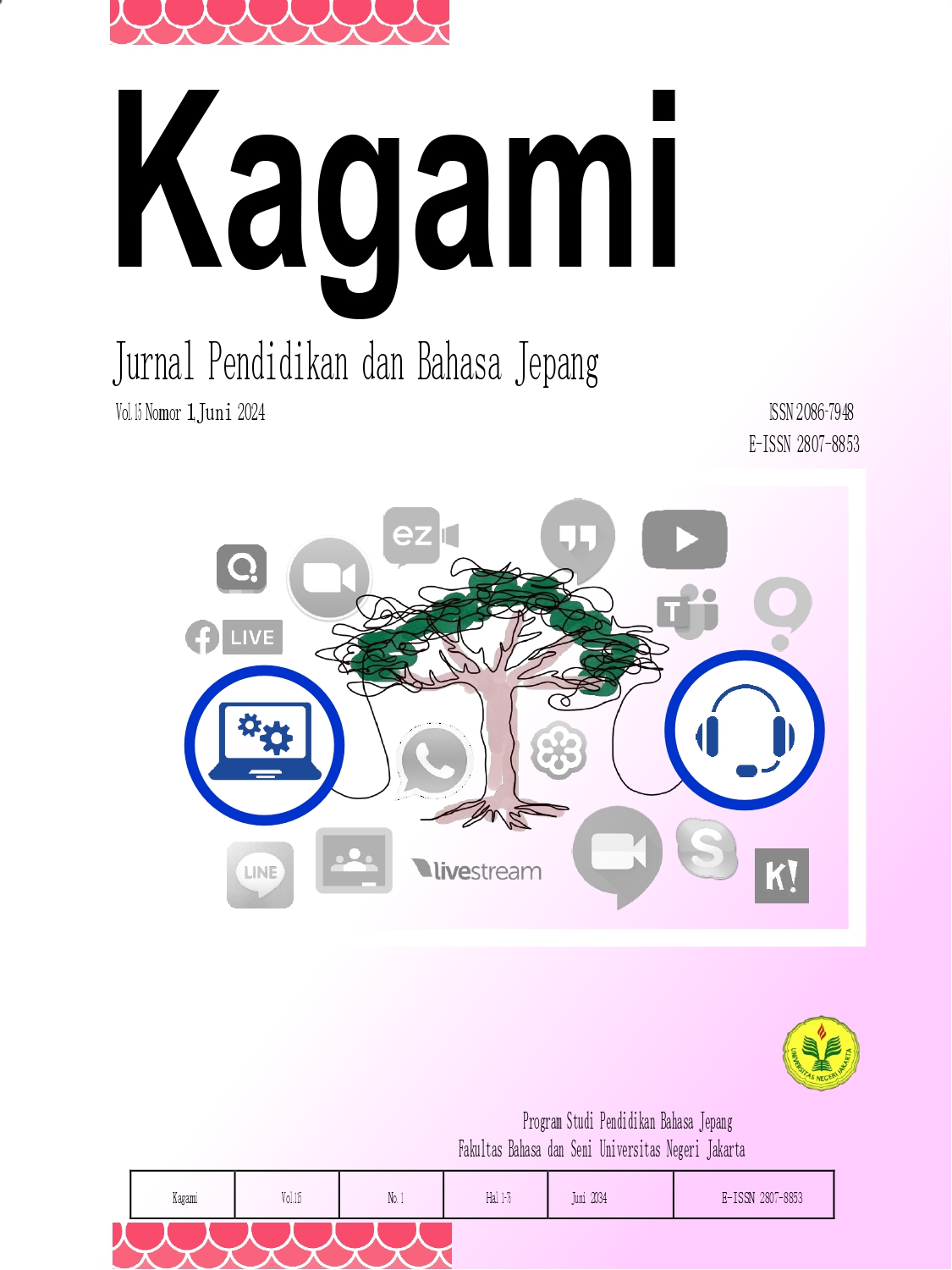OMOIYARI DALAM ANIME KAGAMI NO KOJOU
DOI:
https://doi.org/10.21009/kagami.151.06Keywords:
omoiyari, anime, SPEAKING, sosiopragmaticAbstract
This study aims to determine the function of omoiyari and the factors that influence the use of omoiyari in the anime Kagami no Kojou. This is due to the vulnerable attitude of Japanese people which gives rise to a tendency for Japanese people to communicate indirectly, thus requiring a person to have an omoiyari attitude or high sensitivity to understand the meaning of what the other person is saying. So as a foreign language learner it is important to know the concept of omoiyari which is closely embedded in Japanese society. A total of 22 data were taken from the animated film entitled Kagami no Kojou. This study was analyzed using a qualitative descriptive methods. The data was analyzed using spoken events using Dell Hymes' SPEAKING method. Then analyze and classify the function of omoiyari based on Lebra's theory, and determine the factors underlying the use of omoiyari. The results of the analysis of 22 data, six functions of omoiyari were found, namely 4 data were maintaining of consensus, 9 data were optimization of comfort, 2 data were sentimental vulnerability functions, 3 data were the social echo effect, 2 data were intuitive communication, and 4 data were guilt. Meanwhile, the factors underlying the use of omoiyari are age, gender, situation and groups.
References
Chaer, A., & Leoni, A. (2010). Sosiolinguistik Perkenalan Awal. Jakarta: Rineka Cipta
Gama, F. I. (2024). Pengenalan Anime Sebagai Budaya Populer Jepang. Jurnal Pengabdian Masyarakat Madani (JPMM), 4(1), 21-27. https://doi.org/10.51805/jpmm.v4i1.159
Hara, K. (2006). The concept of omoiyari (altruistic sensitivity) in Japanese relational communication. Intercultural Communication Studies, 15(1), 24. https://cir.nii.ac.jp/crid/1370861704773047051
Irawan, D., & Nurhadi, D. (2020). Penggunaan Omoiyari Hyougen Dalam Serial Animasi Death Note Karya Tsugumi Ohba: Kajian Sosiopragmatik. Jurnal Hikari, 4(1).
Lebra, T. S. (1976). Japanese Patterns of Behavior. Honolulu: University of Hawai’i Press.
Leech, G. (1993). Prinsip-prinsip Pragmatik (Edisi Terjemahan Oleh M.D.D Oka) Jakarta: UI Press
Sugiyono. (2015). Metode Penelitian Pendidikan. Bandung: Alfabeta.
Melati, A. N. P. (2021). Omoiyari Dan Amae Dalam Novel Kitchen Karya Yoshimoto Banana (Kajian Psikososial) (Skripsi, Universitas Negeri Jakarta).
Nazir, M. (2003). Metode Penelitian. Jakarta: PT. Ghalia Indonesia
Purwanti, C. (2019). Makna Bahasa Dalam Komunikasi. ISoLEC Proceedings, 150-154.
Saifudin, A. (2018). “Konteks Dalam Studi Linguistik Pragmatik.” Lite: Jurnal Bahasa, Sastra, Dan Budaya 14(2).
Sukmawati, F. 2017. Bullying di media sosial: Potret memudarnya empati. Jurnal dakwah, 11(1), 77-88.
Yuko, H. (2023). Omoiyari to Jinken no Konzai ni Tomonau kadai “Yori Iki Yasuku Naru” Houto no Tankyuu ni Mukete. Tougou Teki Approach Kenkyuu Dai 4(45).
Yule, G. (1996). Pragmatics. Oxford University Press.
Downloads
Published
Issue
Section
License
Copyright (c) 2024 Avina Theresa, Yuniarsih

This work is licensed under a Creative Commons Attribution 4.0 International License.





